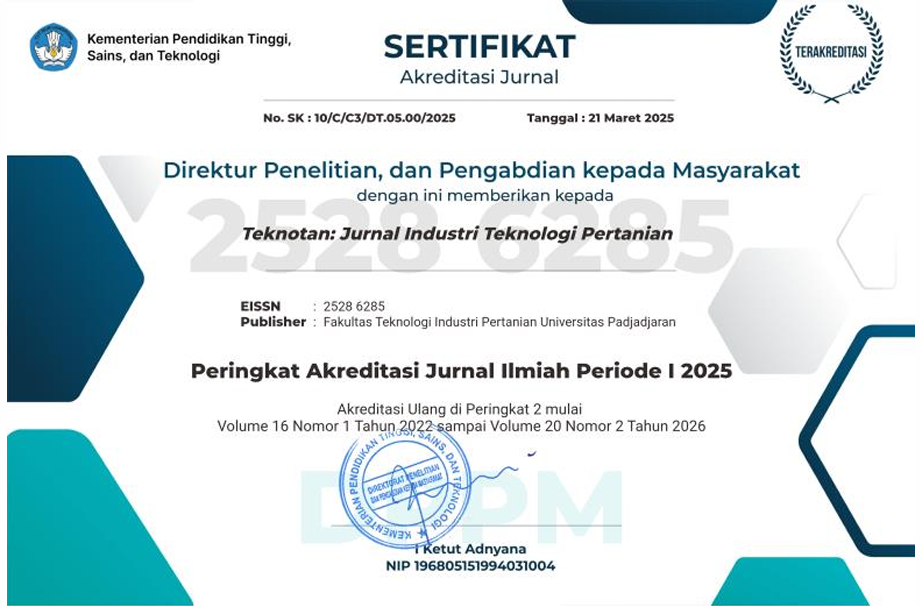Application of Chitosan Edible Coating Using Dip and Spray Method on Postharvest Quality of Cavendish Banana
Abstract
Applying postharvest technologies such as edible coatings is one of effective method to extend the shelf life of bananas. Chitosan, an edible biopolymer, has excellent film-forming properties that allow it to coat fruit surfaces and prolong freshness. The coating method plays a crucial role in the effectiveness of edible coatings. This study aimed to evaluate the effect of coating method on the postharvest quality of Cavendish bananas through statistical analysis. In this research, 1.25% chitosan solution was applied using two methods: dipping and spraying, with uncoated bananas serving as the control. A knapsack power sprayer was used to apply the coating solution in the spray treatment. Bananas were stored at room temperature (26 ± 2°C) and 80 ± 5% relative humidity for 11 days. Results showed that spray-coated bananas experienced the lowest weight loss (14.51%) and disease severity score (3.33), highest value in L* (53,88), b* (30,97), pH (5,82) and pulp-to-peel ratio (2,57), firmest texture (28,06 mm/150g/5sec) along with slowest starch conversion (45%) by day-5. In comparison, dip-coated bananas lost 15.32% weight, highest TSS value (15,87), 65% degraded starch by day-5, lowest a* value (-0,44), and higher disease severity of 4.17. Uncoated bananas showed 15.25% weight loss, completely degraded starch by day five, and the highest disease severity (5.00). These findings indicate that the spray application of chitosan is more effective than dipping in maintaining banana quality during storage and supports its practical application in commercial postharvest handling.
Keywords
Full Text:
PDFReferences
Adi, D. D., Oduro, I. N., & Tortoe, C. (2019). Physicochemical changes in plantain during normal storage ripening. Scientific African, 6, 1–12. https://doi.org/10.1016/J.SCIAF.2019.E00164
Ali, A., Muhammad, M. T. M., Sijam, K., & Siddiqui, Y. (2011). Effect of a novel edible composite coating based on gum arabic and chitosan on biochemical and physiological responses of banana fruits during cold storage. Journal of Agricultural and Food Chemistry, 59(10), 5474–5482. https://doi.org/10.1021/jf200623m
Aziz, T., Hassan, M. K., Talukder, F. U., & Rahman, M. S. (2021). Effects of Different Concentrations of Chitosan on Shelf Life and Quality of Banana Fruit. International Journal of Horticultural Science and Technology, 8(1), 1–12. https://doi.org/10.22059/IJHST.2020.309397.387
Becker, B. R., & Fricke, B. (2002). Transpiration and Respiration of Fruits and Vegetables. Journal of Science et Technique Du Froid, 6, 110–121. https://api.semanticscholar.org/CorpusID:32141733
Belal, M., Sikder, H., Islam, M., Rashid, S. S., & Moazzem, M. S. (2019). Effect of Shrimp Chitosan Coating on Physico-chemical Properties and Shelf Life Extension of Banana. International Journal of Engineering Technology and Sciences, 6(1), 41–54. ttps://doi.org/10.15282/IJETS.V6I1.1390
Blankenship, S. M., Ellsworth, D. D., & Powell, R. L. (1993). A Ripening Index for Banana Fruit Based on Starch Content. Technology and Product Reports, 3(3), 338–339. https://doi.org/10.21273/HORTTECH.3.3.338
Dadzie, B. K., & Orchard, J. E. (1997). Routine post‑harvest screening of banana/plantain hybrids: Criteria and methods (INIBAP Technical Guidelines No. 2). International Network for the Improvement of Banana and Plantain.
Duan, X., Joyce, D. C., & Jiang, Y. (2007). Postharvest Biology and Handling of Banana Fruit. Fresh Produce, 1(2), 140–152.
Elsabee, M. Z., & Abdou, E. S. (2013). Chitosan based edible films and coatings: A review. Materials Science and Engineering: C, 33(4), 1819–1841. https://doi.org/10.1016/J.MSEC.2013.01.010
Emaga, T. H., Andrianaivo, R. H., Wathelet, B., Tchango, J. T., & Paquot, M. (2008). Influence of the stage of maturation and varieties on the chemical composition of banana and plantain peels. Food Chemistry, 103(2), 590–600. https://doi.org/10.1016/j.foodchem.2007.09.033
Eshghi, S., Hashemi, M., Mohammadi, A., Badii, F., Mohammadhoseini, Z., & Ahmadi, K. (2014). Effect of Nanochitosan-Based Coating With and Without Copper Loaded on Physicochemical and Bioactive Components of Fresh Strawberry Fruit (Fragaria x ananassa Duchesne) During Storage. Food and Bioprocess Technology 2014 7:8, 7(8), 2397–2409. https://doi.org/10.1007/S11947-014-1281-2
FAO (Food and Agriculture Organization of the United Nations). (n.d.). Bananas. FAO. Retrieved July 20, 2025, from https://www.fao.org/markets-and-trade/commodities-overview/bananas-tropical-fruits/bananas/en
Garnida, Y. (2020). Edible coating dan Aplikasinya pada Produk Pangan (A. S. Hamidin, M. Revaldi, & M. A. Putri, Eds.). Bandung: Minggu Makmur Tanjung Lestari.
Gol, N. B., & Ramana Rao, T. V. (2011). Banana Fruit Ripening as Influenced by Edible Coatings. International Journal of Fruit Science, 11(2), 119–135. https://doi.org/10.1080/15538362.2011.578512
Harkin, C., Mehlmer, N., Woortman, D. V., Brück, T. B., & Brück, W. M. (2019). Nutritional and Additive Uses of Chitin and Chitosan in the Food Industry. Sustainable Agriculture Reviews, 36, 1–43. https://doi.org/10.1007/978-3-030-16581-9_1
Hossain, M. S., & Iqbal, A. (2016). Effect of shrimp chitosan coating on postharvest quality of banana (Musa sapientum L.) fruits. International Food Research Journal, 23(1), 277–283.
Huang, P.-H., Cheng, Y.-T., Lu, W.-C., Chiang, P.-Y., Yeh, J.-L., Wang, C.-C., Liang, Y.-S., & Li, P.-H. (2024). Changes in nutrient content and physicochemical properties of Cavendish bananas var. Pei Chiao during ripening. Horticulturae, 10(4), 384. https://doi.org/10.3390/horticulturae10040384
Ibañez-Peinado, D., Ubeda-Manzanaro, M., Martínez, A., & Rodrigo, D. (2020). Antimicrobial effect of insect chitosan on Salmonella Typhimurium, Escherichia coli O157:H7 and Listeria monocytogenes survival. PloS One, 15(12). https://doi.org/10.1371/JOURNAL.PONE.0244153
Jianglian, D., & Shaoying, Z. (2013). Application of Chitosan Based Coating in Fruit and Vegetable Preservation: A Review. J Food Process Technol, 4(5), 4–5. https://doi.org/10.4172/2157-7110.1000227
Juncai, H., Yaohua, H., Lixia, H., Kangquan, G., & Satake, T. (2015). Classification of ripening stages of bananas based on support vector machine. International Journal of Agricultural and Biological Engineering, 8(6), 99–103. https://doi.org/10.25165/IJABE.V8I6.1275
Kusumiyati, Hadiwijaya, Y., Putri, I. E., Mubarok, S., & Hamdani, J. S. (2020). Rapid and non-destructive prediction of total soluble solids of guava fruits at various storage periods using handheld near-infrared instrument. IOP Conference Series: Earth and Environmental Science, 458(1), 1–7. https://doi.org/10.1088/1755-1315/458/1/012022
Luo, Y., & Wang, Q. (2013). Recent Advances of Chitosan and Its Derivatives for Novel Applications in Food Science. Journal Food Processing & Beverages, 1(1), 1–13.
Lustriane, C., Dwivany, F. M., Suendo, V., & Reza, M. (2018). Effect of chitosan and chitosan-nanoparticles on post harvest quality of banana fruits. Journal of Plant Biotechnology, 45(1), 36–44. https://doi.org/10.5010/JPB.2018.45.1.036
Maduwanthi, S., & Marapana, R. (2017). Biochemical changes during ripening of banana: A review. International Journal of Food Science and Nutrition, 2(5), 166–170.
Malmiri, H. J., Osman, A., Tan, C., & Rahman, R. (2011). Development of an edible coating based on chitosan-glycerol to delay “Berangan” banana (Musa sapientum cv. Berangan) ripening process. International Food Research Journal, 18(3), 989–997. https://doi.org/10.1002/fsn3.2058
No, H. K., Kim, S. H., Lee, S. H., Park, N. Y., & Prinyawiwatkul, W. (2006). Stability and antibacterial activity of chitosan solutions affected by storage temperature and time. Carbohydrate Polymers, 65(2), 174–178. https://doi.org/10.1016/J.CARBPOL.2005.12.036
Owusu-Akyaw, & Oduro, K. (2021). Edible Coating. In Postharvest Technology - Recent Advances, New Perspectives and Applications (pp. 1–16). IntechOpen. 10.5772/intechopen.101283
Parijadi, A. A. R., Yamamoto, K., Ikram, M. M. M., Dwivany, F. M., Wikantika, K., Putri, S. P., & Fukusaki, E. (2022). Metabolome Analysis of Banana (Musa acuminata) Treated With Chitosan Coating and Low Temperature Reveals Different Mechanisms Modulating Delayed Ripening. Frontiers in Sustainable Food Systems, 6, 1–14. https://doi.org/10.3389/FSUFS.2022.835978
Park, S. I., Daeschel, M. A., & Zhao, Y. (2004). Functional properties of antimicrobial lysozyme-chitosan composite films. Journal of Food Science, 69(8), 1–7. https://doi.org/10.1111/J.1365-2621.2004.TB09890.X
Pierre, B. (2016). Banana Peel Physiological Post-Harvest Disorders: A Review. MOJ Food Processing & Technology, 3(1), 1–7. https://doi.org/10.15406/mojfpt.2016.03.00060
Raghav, P. K., Agarawi, N., & Saini, M. (2016). Edible Coating of Fruits and Vegetables: A Review. International Journal of Scientific Research and Modern Education, 1(1), 188–204.
Sharma, P., Shehin, V. P., Kaur, N., & Vyas, P. (2018). Application of edible coatings on fresh and minimally processed vegetables: a review. International Journal of Vegetable Science, 25(3), 295–314. https://doi.org/10.1080/19315260.2018.1510863
Shinga, M. H., Silué, Y., & Fawole, O. A. (2025). Recent Advancements and Trends in Postharvest Application of Edible Coatings on Bananas: A Comprehensive Review. Plants, 14(4), 581. https://doi.org/10.3390/plants14040581
Sivakumar, D., Hewarathgamagae, N. K., Wijeratnam, R. S. W., & Wijesundera, R. L. C. (2008). Effect of ammonium carbonate and sodium bicarbonate on anthracnose of papaya. Phytoparasitica, 30(5), 486–492. https://doi.org/10.1007/BF02979753
Stossel, P., & Leuba, JL. (1984). Effect of chitosan, chitin and some aminosugars on growth of various soilborne phytopathogenic fungi. Journal Phytopathol, 111, 82–90.https://doi.org/10.1111/j.1439-0434.1984.tb04244.x
Suseno, N., Savitri, E., Sapei, L., & Padmawijaya, K. S. (2014). Improving Shelf-life of Cavendish Banana Using Chitosan Edible Coating. Procedia Chemistry, 9, 113–120. https://doi.org/10.1016/J.PROCHE.2014.05.014
Toskas, G., Brünler, R., Hund, H., Hund, R. D., Hild, M., Aibibu, D., & Cherif, C. (2013). Pure chitosan microfibres for biomedical applications. Autex Research Journal, 13(4). https://doi.org/10.2478/v10304-012-0041-5
Tourky, M. N., Tarabih, M. E., & El-Eryan, E. E. (2014). Physiological studies on the marketability of williams banana fruits. American Journal of Plant Physiology, 9(1), 1–15. https://doi.org/10.3923/AJPP.2014.1.15
Varma, V., Lin, T. K., Aoun, D., & Fanzo, J. C. (2025). Food loss and waste in fruits and vegetables: A global perspective. Nature Food, 6(7), 849–857. https://doi.org/10.1038/s43016-025-01130-1
Wang, D., Zhang, H., Wu, F., Li, T., Liang, Y., & Duan, X. (2013). Modification of pectin and hemicellulose polysaccharides in relation to aril breakdown of harvested longan fruit. International Journal of Molecular Sciences, 14(12), 23356–23368. https://doi.org/10.3390/IJMS141223356
Yamamoto, K., Amalia, A., Putri, S. P., Fukusaki, E., & Dwivany, F. M. (2018). Expression Analysis of 1-aminocyclopropane-1-carboxylic Acid Oxidase Genes in Chitosan-Coated Banana. HAYATI Journal of Biosciences, 25(1), 18–18. https://doi.org/10.4308/HJB.25.1.18
Zomo, S. A., Ismail, S. M., Jahan, M. S., Kabir, K., & Kabir, M. H. (2014). Chemical properties and shelf life of banana (Musa sapientum L.) as influenced by different postharvest treatments. The Agriculturists, 12(2), 6–1. http://dx.doi.org/10.3329/agric.v12i2.21725.
DOI: https://doi.org/10.24198/jt.vol19n2.11
Refbacks
- There are currently no refbacks.
Indexed by:

This work is licensed under a Creative Commons Attribution 4.0 International License (CC BY-SA 4.0)


1.png)
.png)







